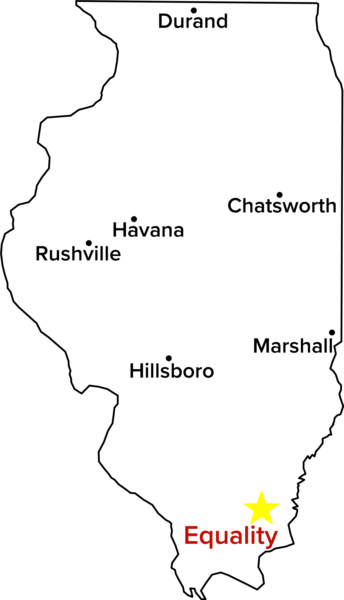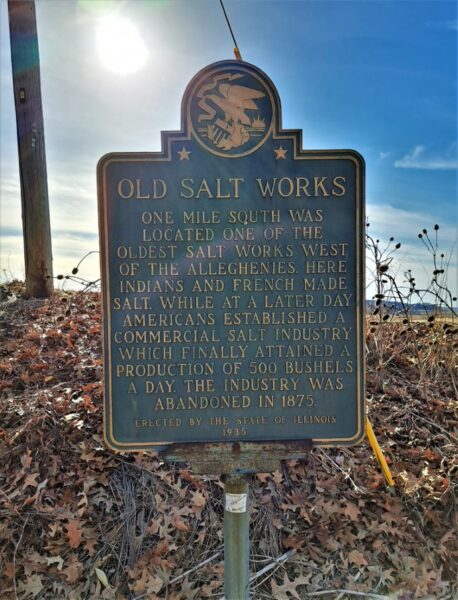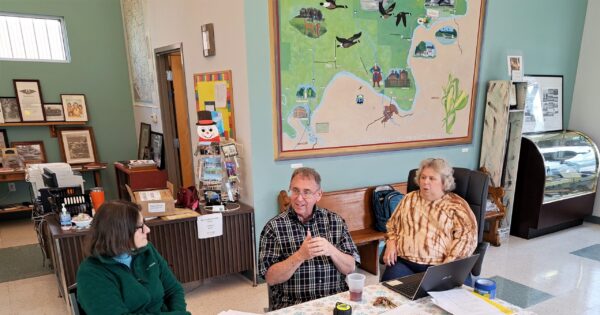
In 2018-19, Illinois Humanities facilitated a statewide tour of a Smithsonian Institution-produced Museum on Main Street exhibition called Crossroads: Change in Rural America. One segment of Crossroads invited viewers to consider what businesses and institutions they would include in a rural community if they could choose only a few.
The approximately 550 residents of Equality, located adjacent to the Shawnee National Forest in southeastern Illinois’s Gallatin County, have only a few businesses and institutions in their community, but they’ve chosen them with remarkable perspicacity. Their strategic decision-making, resulting in a well-integrated network of mutually complementary amenities, has enhanced their local economy and quality of life.
That’s why the Smithsonian chose to feature Equality in its newest Museum on Main Street exhibition, Spark! Places of Innovation. Spark! will visit seven Illinois communities between June 2023 and March 2024—starting, appropriately, with Equality.
“I wrote the application with three things in mind: the cutting-edge technology of Shawnee Communications; the arts, with the 276 Art Exchange; and the hospitality industry, with The Red Onion,” explained Mark York, a civic leader who, at the encouragement of Illinois Humanities, applied to have Equality profiled in Spark! “The first is what has the most employees, and the last is what brings people to town, and, hopefully, the 276 makes them want to come back.”
The 276 Art Exchange is what the Smithsonian ultimately selected to represent Equality in the Spark! exhibition. Opened in January 2020, the 276 sells work by 70 southern Illinois artists.
The Gallatin County Tourism Committee, which will host Spark!, provides volunteer labor to staff the 276. In return, the 276 subsidizes electricity for the nearby tourism facility, the Ohio River Visitors Center—managed by Mark and his wife, Nadine York—which will house Spark! from June 17 to July 22.
The symbiotic relationships that characterize Equality make the community a fitting place to begin the Illinois tour of Spark! Places of Innovation. So does Gallatin’s distinction as one of our state’s original 15 counties.

Two Gallatin County communities, Equality and Shawneetown, were among Illinois’s most important hubs of governmental and economic activity in the early decades of its statehood. They owed their prominence largely to salt extraction, often considered Illinois’s first non-agricultural industry. The local exhibition accompanying Spark! and a series of related presentations will examine that industry and its human impact.
Native Americans utilized the saline springs near present-day Equality long before 18th-century French colonists did likewise. Later, Anglo-Americans extracted salt on a massive scale, relying so extensively on enslaved labor that Equality became the one place where Illinois’ original Constitution explicitly permitted slavery—a sad irony, given the community’s name.
Many Gallatin County residents know that John Hart Crenshaw, who leased the salt works, enslaved numerous Black people, but they tend to think of him as an exception, according to Mark. He and Nadine believe that the broader presence of slavery in early-19th-century southeastern Illinois, often under the guise of coerced indentured servitude, remains under-recognized.
“Two hundred years ago this year, 1823, was the referendum that would have turned Illinois from free to slave,” Mark noted. “It failed because people in the north and churches in the south fought against it, but the salt barons and many other people in the south fought for it, and that history needs to be acknowledged.”
Nadine and Mark hope that the Spark! companion exhibition and lecture series might incentivize the reopening of Crenshaw’s house, a state historic site, which could further the acknowledgment of that history while also drawing visitors.
Gallatin County’s position within Illinois has changed significantly since early statehood. It now ranks 101st among Illinois’s 102 counties in population density. Still, its residents’ perseverance and ingenuity make it exactly the kind of “place of innovation” that Spark! aims to highlight.
“It’s a very cooperative effort—the only way things can happen in a town this size,” Mark commented. “People have to work together and wear multiple hats.”

Many such hats rest on the heads of Mark and Nadine York. Both Gallatin County natives, they taught in the local school for 30-plus years. They remain involved in community service activities ranging from a ministry providing transportation for medical appointments to a University of Illinois Extension initiative seeking to remedy the county’s status as a food desert.
Consequently, Nadine remarked, “We just kind of know all the needs of a poor county in the middle of nowhere.”
We respectfully beg to differ, Nadine. Thanks to the dedication of people like you and Mark, Gallatin County is definitely somewhere. Your neighbors will be reminded of that when Spark! arrives in Equality on June 17, and people throughout Illinois and the United States will learn Equality’s inspiring story when the exhibition visits their own communities in the coming months.
These exhibitions and lecture series are hosted by the Gallatin County Tourism Committee. For more information, visit facebook.com/276ArtExchange or call (618) 499-3801.
About Museum on Main Street
Museum on Main Street is a partnership between the Smithsonian Institution Traveling Exhibition Service and state humanities councils, including Illinois Humanities. It not only enables Illinoisans to experience Smithsonian-produced exhibitions in their own communities but also gives the local cultural organizations that host these exhibitions opportunities to enhance their roles within their communities and regions, attract new audiences and volunteers, expand their knowledge and resource bases, and develop skills that can be applied toward future exhibitions and programs.
About Illinois Humanities
Illinois Humanities, the Illinois affiliate of the National Endowment for the Humanities, is a statewide nonprofit organization that activates the humanities through free public programs, grants, and educational opportunities that foster reflection, spark conversation, build community and strengthen civic engagement. We provide free, high-quality humanities experiences throughout Illinois, particularly for communities of color, individuals living on low incomes, counties and towns in rural areas, small arts and cultural organizations, and communities highly impacted by mass incarceration. Founded in 1974, Illinois Humanities is supported by state, federal, and private funds.
Learn more at ilhumanities.org and on Facebook, Twitter, Instagram, and LinkedIn @ILHumanities.
Featured Image: People browsing the 276 Art Exchange in Equality, Illinois